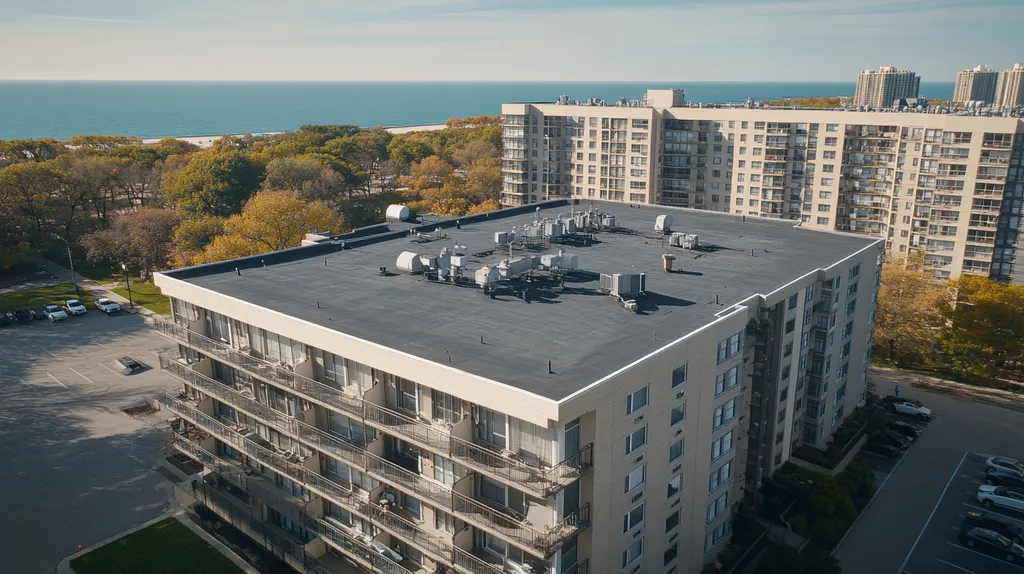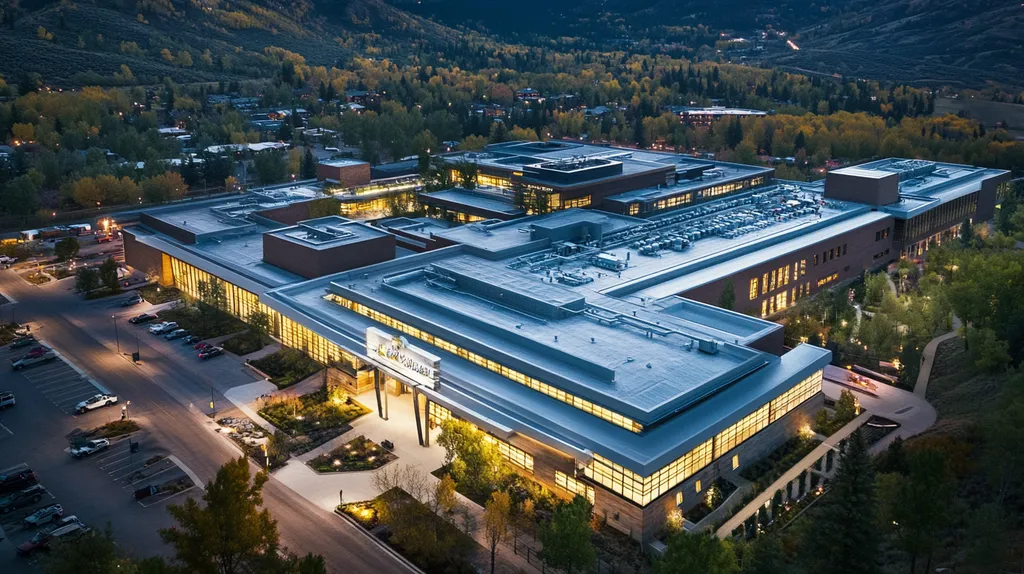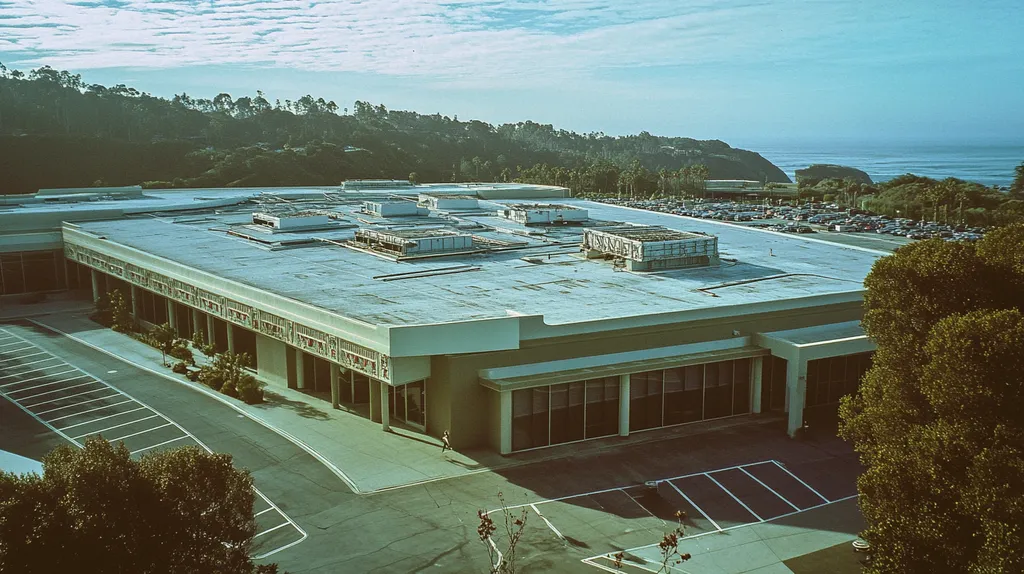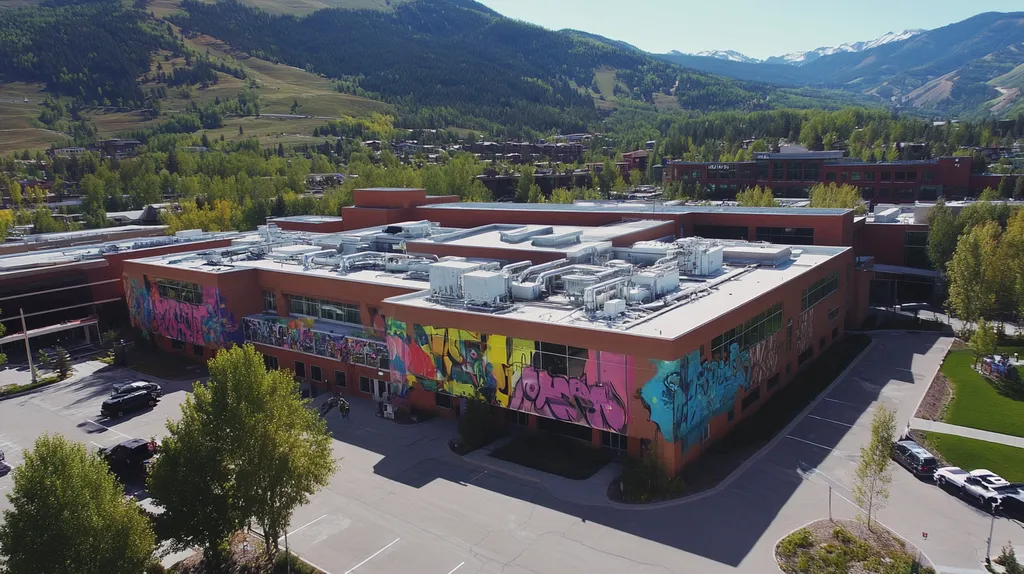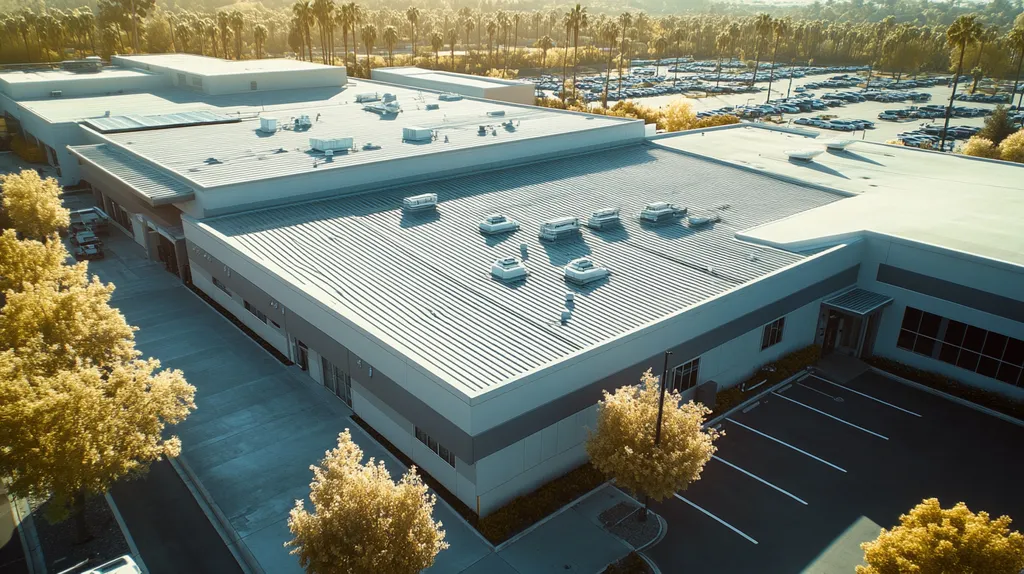Over 40% of commercial roofs fail prematurely due to poor material selection, costing property owners millions in repairs and business disruptions annually.
Choosing the right roofing materials has become increasingly complex as building codes evolve and energy efficiency demands intensify.
This comprehensive guide examines critical factors in selecting durable commercial roofing materials, from weather resistance and thermal properties to lifecycle costs and compliance requirements.
By following these evidence-based material selection protocols, property professionals can maximize roof longevity while minimizing maintenance expenses and regulatory risks.
SECTION 1: PERFORMANCE FACTORS
Selecting the appropriate materials for a commercial roof is a pivotal decision that influences its lifespan and effectiveness. Statistics reveal that roughly 30% of commercial roofs suffer serious failures within the first 15 years, primarily due to inadequate material choices. To protect your investment, it’s crucial to consider performance factors such as weather resistance, thermal durability, and seam integrity.
Material Properties and Weather Resistance
The materials chosen for a commercial roof must endure a variety of weather conditions, including intense rain, powerful winds, and extreme temperatures. TPO (thermoplastic olefin) membranes are increasingly favored for their ability to resist harsh UV rays and pollutants, often performing better than traditional options like EPDM in specific climates. This durability translates into a longer-lasting roof.
Additionally, evaluating materials for their water resistance is critical. Membranes with a high elongation percentage are adept at handling the thermal expansion and contraction that fluctuating temperatures cause. Protecting against water intrusion is essential, as any leaks can lead to mold growth, structural damage, and costly repairs.
Investing in weather-resistant materials not only safeguards the roof but can also lead to financial advantages. Properties that utilize advanced materials may experience fewer insurance claims for roof damage, ultimately lowering maintenance costs over the roof’s lifetime.
Key Action Items
Thermal and UV Durability Assessment
Thermal durability is essential when choosing roofing materials, as they face direct sunlight daily. Highly reflective roofing can effectively minimize heat absorption, leading to reduced cooling energy costs. Selecting materials that withstand temperature swings without degrading is vital for maintaining structural integrity over time.
Moreover, UV resistance plays a significant role in extending the life of commercial roofs. Continuous UV exposure can cause materials to become brittle and crack, leading to costly repairs. By opting for materials with strong UV resistance, property owners can reduce repair frequency and extend the replacement interval.
By prioritizing thermal stability and UV protection, property owners can enhance roof durability and improve energy efficiency. This strategy not only prolongs the roof’s lifespan but can also lead to considerable savings on energy bills.
Key Action Items
Seam Integrity and Waterproofing Checks
Seam integrity is a vital component of any commercial roofing system, as seams represent potential weak points where leaks can develop. High-quality materials should utilize reliable seam sealing methods, such as heat welding or adhesive bonding, to reduce water infiltration risks. Routine inspections of seams are crucial, especially during seasonal shifts.
Conducting waterproofing checks is equally important, as these assessments identify the strength of seams and transitions within the roofing system. Older materials often require more frequent inspections to ensure their waterproofing capabilities remain intact. Proactive monitoring can prevent substantial water damage that threatens the roof’s overall effectiveness.
In summary, a comprehensive evaluation of seam integrity and waterproofing is essential for both selection and ongoing maintenance. Properties that focus on these elements can avoid hefty repair costs and boost the longevity of their roof, thus safeguarding their investments.
Key Action Items
SECTION 2: FINANCIAL CONSIDERATIONS
The financial implications of selecting roofing materials can substantially influence the bottom line for commercial property owners and facilities managers. Initial material costs, ongoing maintenance, and potential savings play critical roles in the decision-making process. Understanding these aspects is vital to ensuring that a roofing system remains durable and efficient over time. The stakes are high; choosing the wrong materials can lead to unforeseen expenses and decline in property value.
Initial Material and Installation Costs
Understanding the initial costs of roofing materials and installation is essential for proper budgeting. Different materials vary widely in price, making it necessary to evaluate choices thoroughly. While traditional asphalt shingles may seem economically favorable at first, they often incur higher repair costs later.
Flat roofing systems generally demand a higher initial investment but offer extended durability. Opting for materials like thermoplastic polyolefin (TPO) or ethylene propylene diene monomer (EPDM) can yield long-term savings, reducing repair costs by about 20% in research findings.
Labor costs are another crucial financial aspect. Hiring experienced roofing contractors may come at a premium, but their expertise can help avert costly installation errors. Consequently, a complete cost analysis should factor in both materials and labor for a clearer picture of overall expenses.
Key Action Items
Lifecycle Cost and Maintenance Expenses
Lifecycle costs encompass every expense associated with a roofing system from installation to eventual replacement. This includes ongoing maintenance, repairs, and disposal. Investing in durable materials can significantly reduce these costs, making material selection critically important.
For instance, metal roofs may demand a higher initial outlay, but they often require far less maintenance than asphalt roofs. With a lifespan of 40-70 years, metal roofs can dramatically lower repair and replacement frequencies.
Regular maintenance is essential for all roofing materials. Failing to perform routine inspections can lead to extensive and expensive damages over time. Implementing predictive maintenance strategies helps spot issues early on, which saves money in the long run.
Key Action Items
Return on Investment and Energy Savings
Return on investment (ROI) represents a crucial factor tied to material selection and energy efficiency. Choosing the right roofing system can result in substantial energy savings, which is a significant economic advantage for commercial properties.
For instance, reflective roofing materials can reduce heat absorption and lower cooling costs by as much as 30%. This not only lessens energy expenses but also prolongs the life of HVAC systems, leading to even greater savings. Investing in energy-efficient materials can result in an ROI that far exceeds the original expenditure.
Additionally, many areas offer tax incentives or rebates for energy-efficient roofing installations, allowing property owners to capitalize on sustainable options for even greater financial rewards. Understanding energy savings and ROI can make a strong case for selecting high-quality roofing materials.
Key Action Items
SECTION 3: COMPLIANCE REQUIREMENTS
Navigating compliance requirements is essential for any commercial roofing project. Failing to meet local building codes can lead to significant financial penalties and the possibility of expensive rework. In fact, nearly 20% of roofing projects face delays due to non-compliance. Upholding relevant regulations not only ensures legal adherence but also protects the investment and longevity of the property. This section highlights key compliance issues you must consider when selecting roofing materials.
Building Codes and Roofing Standards
Building codes provide vital guidelines for constructing safe and durable roofing systems. Each locality has unique regulations that dictate minimum material standards and installation practices. Ignoring these codes can result in failed inspections and costly rejections, jeopardizing both timelines and budgets.
In many jurisdictions, roofing materials must conform to stringent standards established by organizations like the American Society for Testing and Materials (ASTM). For example, roofing materials in high-wind areas should meet specific wind uplift ratings. Selecting compliant materials enhances longevity while mitigating risks associated with non-compliance.
Additionally, staying updated on local code amendments is critical. Changes regarding energy efficiency, for instance, can significantly influence your material choices. Collaborating closely with roofing contractors can help ensure comprehensive compliance with all relevant standards.
Key Action Items
Fire Resistance and Safety Regulations
Fire resistance is a critical element when selecting roofing materials for commercial structures. Many facilities must adhere to the National Fire Protection Association (NFPA) codes, which outline strict fire safety standards. Compliance not only protects property but also safeguards lives.
For example, properties in wildfire-prone areas are often required to use Class A roofing materials, the highest level of fire resistance. Selecting appropriate materials goes beyond legal requirements and is key to protecting occupants from potential disasters.
Regular assessments of fire safety compliance are crucial, especially for older buildings. These roofs may need upgrades to align with current fire resistance standards or to replace worn materials that have lost effectiveness. Neglecting to perform these updates can lead to increased liabilities and higher insurance costs.
Key Action Items
Environmental and Energy Code Compliance
Environmental and energy codes are increasingly significant in commercial roofing. These regulations often require energy efficiency measures that promote sustainability and reduce long-term operational costs. Compliance fulfills legal responsibilities while boosting a property’s marketability.
Many regions follow the International Energy Conservation Code (IECC), which specifies requirements for roofing materials related to insulation, reflectivity, and energy performance. This may involve selecting materials that meet stringent solar reflectance index (SRI) values to minimize heat gain.
Additionally, utilizing green roofing options, like vegetative roofs, can help meet both local and federal environmental standards. These systems not only comply with regulations but also offer benefits such as improved stormwater management and insulation properties.
By proactively addressing environmental compliance, property owners can leverage tax incentives and rebates aimed at enhancing energy efficiency. This reduces immediate costs and supports sustainable building practices increasingly valued in today’s market.
Key Action Items
SECTION 4: RISK MANAGEMENT
Effective risk management is essential for ensuring the longevity and reliability of commercial roofing systems. Property owners and facility managers need to actively tackle concerns like water leakage and structural damage. Shockingly, approximately 60% of building maintenance budgets are consumed by water-related repairs. By identifying and addressing these risks early, property professionals can prevent expensive repairs and prolong their roofs’ life.
Leakage and Ponding Water Risk Identification
Water leakage can wreak havoc on a commercial roof. Ponding water not only weakens roofing materials but also encourages mold growth. Regular inspections are crucial in identifying areas where water accumulates, particularly on flat or low-slope roofs.
Property owners should be vigilant for signs of leaks, such as water stains on ceilings or walls, indicating potential underlying problems. Infrared scanning technology can be a game-changer, allowing professionals to uncover hidden leaks before they escalate into larger issues.
Establishing a routine inspection schedule is critical; recommendations include checking at least twice a year and after severe weather events. Taking swift action can help mitigate long-term damage effectively. Partnering with experienced roofing contractors for evaluations can also provide insights on preventing leaks and ponding scenarios.
Key Action Items
Damage from Foot Traffic and Weather Impacts
Foot traffic and extreme weather pose substantial risks to roofing integrity. Even minimal wear in high-traffic areas can lead to cracks or punctures. To minimize potential damage, property managers should establish clear rooftop access protocols.
For instance, installing protective walkways or mats can help evenly distribute weight, thereby reducing wear on roofing materials. Understanding the specific roof system in place is critical, as some materials are more fragile than others.
Extreme weather conditions like heavy winds and hail can exacerbate these vulnerabilities. Severe storms cost U.S. businesses over $1 billion annually in roof repairs, highlighting the need for regular resilience assessments against such challenges. Educating staff on best practices for roof maintenance can further reduce risks associated with foot traffic and adverse weather.
Key Action Items
Inspection and Preventive Maintenance Planning
Preventive maintenance serves as the backbone of a sturdy commercial roofing system. A solid plan integrates regular inspections with timely repairs, as many roofing failures stem from inadequate maintenance practices.
Property managers should maintain thorough documentation of roof conditions during inspections, noting areas needing immediate attention. This historical record can help predict potential future issues based on past performance.
Routine maintenance not only enhances the lifespan of roofing materials but can also lead to substantial cost savings. Manufacturers typically provide maintenance schedules for different roof types, and adhering to these recommendations is key. Investing in preventive strategies can reduce repair costs by up to 50% compared to reactive maintenance.
Key Action Items
SECTION 5: OPERATIONAL PROCEDURES
Establishing effective operational procedures is crucial for the longevity of commercial roofing systems. Neglecting routine inspections or scheduled maintenance can result in significant repair costs and extended roof downtime. Studies indicate that nearly 50% of roofing failures are due to insufficient maintenance practices. This section outlines key protocols to keep roofs in prime condition, including systematic inspection routines, thorough documentation, and proactive maintenance strategies.
Routine Roof Inspection Protocols
Regular roof inspections are essential for catching potential issues before they worsen. Property owners should aim to conduct visual inspections at least twice a year, targeting the spring and fall for optimal timing. During these inspections, check for visible damage, such as cracks, blisters, and debris buildup.
Engaging a professional roofing contractor can enhance these assessments. They bring specialized equipment to detect hidden issues like structural leaks or membrane fatigue, along with examining the condition of vital components such as flashing and drains.
Documenting the findings of each inspection is key. This historical record is invaluable for tracking a roof’s condition over time and planning necessary future investments. Additionally, implementing seasonal checks before severe weather can mitigate unexpected damages that threaten roof integrity.
Key Action Items
Documenting and Reporting Roof Conditions
Keeping consistent documentation of roof conditions is vital for effective management. Property managers should develop a standardized reporting method during each inspection. This can include taking photographs, making detailed notes, and assigning condition ratings.
A clear reporting system helps bridge communication gaps during maintenance discussions. Ensuring everyone is on the same page regarding the roof’s condition allows for better planning and coordination with vendors when addressing repairs.
Utilizing digital maintenance management software can streamline documentation, enabling alerts for upcoming inspections and necessary maintenance tasks. Comprehensive records are crucial for informed decision-making about repairs, replacements, and for supporting warranty claims associated with roofing materials.
Key Action Items
Scheduled Maintenance and Repair Actions
Prioritizing scheduled maintenance is essential for extending the lifespan of commercial roofs. Routine tasks, such as cleaning gutters and drains, can prevent water buildup that leads to leaks and structural issues.
Creating a maintenance calendar ensures no vital tasks are overlooked. This calendar should encompass seasonal inspections, preventive maintenance activities, and prompt repairs after severe weather events.
Addressing minor repairs quickly—like sealing small leaks or replacing worn seals—can prevent larger, costlier problems later. Collaborating with professional roofing services for both planned maintenance and urgent repairs will yield better insights into material care, further enhancing durability.
Key Action Items
SECTION 5: OPERATIONAL PROCEDURES
Establishing effective operational procedures is critical for maintaining the durability of commercial roofing systems. Neglecting routine inspections or scheduled maintenance can lead to costly repairs and extended roof downtime. Studies indicate that nearly 50% of roofing failures arise from inadequate maintenance practices. This section outlines essential protocols to ensure roofing systems remain in top condition, focusing on inspection routines, documentation practices, and proactive maintenance strategies.
Routine Roof Inspection Protocols
Regular roof inspections are crucial for identifying issues before they escalate into major problems. Property owners should conduct visual inspections at least twice a year, ideally during spring and fall, monitoring for visible damage like cracks, blisters, and debris accumulation.
Hiring a professional roofing contractor can enhance these assessments. Their expertise allows them to utilize specialized equipment to detect hidden problems such as leaks or membrane fatigue, as well as assess critical components like flashing and drains.
Documenting inspection findings is vital for tracking changes over time. This historical data helps property managers plan future investments and maintain the roof’s health. Implementing seasonal checks before severe weather can also mitigate unexpected damages that threaten roof integrity.
Key Action Items
Documenting and Reporting Roof Conditions
Consistent documentation of roof conditions is vital for effective property management. Property managers should establish a standardized reporting process during each inspection, which may include photographs, detailed notes, and condition ratings.
A clear reporting system is essential for seamless communication during maintenance discussions. This ensures all parties understand the roof’s condition, necessary interventions, and any critical issues that need addressing, especially when coordinating with roofing vendors or planning budgets.
Utilizing digital maintenance management software can streamline the documentation process. These tools can generate alerts for upcoming inspections and necessary maintenance tasks, promoting efficiency in managing roof conditions.
Key Action Items
Scheduled Maintenance and Repair Actions
Prioritizing scheduled maintenance is essential for extending the lifespan of commercial roofs. Routine tasks, such as cleaning gutters and drains, can prevent water accumulation that leads to leaks and structural damage.
Creating a maintenance calendar ensures no vital tasks are overlooked. This calendar should encompass seasonal inspections, preventive maintenance actions, and prompt repairs following severe weather events.
Addressing minor repairs quickly—like sealing small leaks or replacing worn seals—can prevent larger, costlier problems later. Collaborating with professional roofing services for both planned maintenance and urgent repairs provides valuable insights into material care, enhancing roof durability.
Key Action Items
The Bottom Line
With 40% of commercial roofs failing prematurely due to poor material selection, property owners cannot afford to make uninformed choices about roofing materials.
The financial impact of selecting substandard materials extends far beyond initial costs, often resulting in repair expenses that exceed the original investment by 300%.
Success requires a systematic approach: choosing weather-resistant materials that meet local building codes, implementing rigorous inspection protocols, and following manufacturer-recommended maintenance schedules.
By focusing on material durability, regulatory compliance, and preventive maintenance, property professionals can extend roof lifespans by 15-20 years while reducing lifetime costs by up to 50%.
The future of commercial roofing lies in selecting materials that balance performance, sustainability, and long-term value.
FREQUENTLY ASKED QUESTIONS
Q. What performance factors should I consider for a commercial roof?
A. When selecting materials, focus on weather resistance, thermal durability, and seam integrity. Adequate performance in these areas can prevent serious issues like leaks and structural damage, thus enhancing the roof’s lifespan and effectiveness.
Q. How do financial considerations impact commercial roof selection?
A. Initial costs, lifecycle expenses, and potential savings are critical factors. Investing in durable materials may incur higher upfront costs but can lead to long-term savings by reducing repair needs and maintenance frequency.
Q. What are key compliance requirements for a commercial roof?
A. Compliance includes adherence to local building codes and standards, fire safety regulations, and energy efficiency mandates. Ignoring these can lead to fines, rework, and increased insurance costs, adversely affecting your investment.
Q. How can I manage risks associated with a commercial roof?
A. Regular inspections to identify leakage and ponding risks are essential. Implementing preventive maintenance practices and training staff on roof care can help mitigate damage from foot traffic and severe weather, promoting longevity.
Q. What operational procedures are necessary for commercial roofs?
A. Establish routine inspection protocols, document conditions meticulously, and prioritize scheduled maintenance tasks. This structured approach helps catch issues early, ensuring effective maintenance and prolonging the roof’s lifespan.
Q. Which materials are best for energy efficiency in commercial roofs?
A. Energy-efficient materials include reflective roofing options like TPO or EPDM, which help minimize heat absorption. These choices can lower cooling costs and enhance HVAC efficiency, benefitting your operational expenses in the long run.
Q. How should I prepare for extreme weather events affecting my roof?
A. Regularly assess your roof’s resilience, improve drainage systems, and inspect seams before severe weather. Quick repairs after storms and proactively maintaining critical roof features will reduce the risk of damage and costly repairs.

